White Ibis
Another benefit to being confined to our Florida condo sunroom while recovering after my hospitalization was the opportunity to observe bird activity as the different species went about their daily routines. When on a birding trip or simply traveling around looking for birds we seldom take the time to sit and watch how they go about their daily business. This point was driven home to me by watching for over 13 minutes as a White Ibis went from catching a frog to getting it down its gullet.
Unfortunately, I did not have my camera up and ready to record the White Ibis as it caught the frog, but I was able to document its progress as it moved from the edge of the pond (photo 1) and was being chased by another White Ibis that may have been intent on stealing the frog (photo 2). The Ibis then flew with its catch along the pond (photo 3) to a field well away from the rest of the flock of White Ibis in the area but still well within my field of view.
That wonderful long down-curved beak may be great for probing and digging for small organisms that constitute a major part of the Ibis’s diet, but it sure poses a problem for the Ibis when it comes to swallowing a frog. The Ibis is able to pick the frog up without any difficulty, but getting it lined up just right for swallowing is much more of a problem (photo 4). The first time the frog was lined up just right, its legs stuck out on both sides (photo 5) blocking the frog from going smoothly into the Ibis’s mouth.
On one of the several attempts the Ibis made to get the frog lined up just right, it even tried to bring the frog in from the side (photo 6, and at the top of the page). As you can imagine, that did not work. However, after six different attempts, during which the Ibis laid the frog down on the ground and started over from scratch each time, the Ibis finally got the frog lined up just right (photo 7) and was able to get it well into its mouth with legs sticking out (photo 8) and finally, down the hatch (photo 9).
As noted above, it took over 13 minutes from the time the White Ibis caught the frog until it was finally able to get it down the hatch. I have 166 photos of the entire process not including the catching of the frog, which I judiciously decided not to inflict upon you (not that our webmaster would have allowed me to).
But think about it: You and I sit at a table with knife and fork and neatly carve up our food for easy eating. Birds do not have it that easy. All they have are their bills to eat with. Some birds can hold food down with their feet while they peck away at it. Our Tufted Titmouse and White-breasted Nuthatches hold sunflower seeds with their feet as they hammer away at the seed hulls to get to the kernels inside, but then may swallow the kernel whole or break it into smaller pieces.
Can you imagine not being able to use your hands to eat. Can you also imagine having only your mouth to catch your meal and then eat your catch, swallowed whole, right down the gullet. I suppose if our ancestors had spent thousands of years developing the techniques and learning the necessary routines, we would undoubtedly have adapted the same way the birds have. On the other hand, it is nice to be able to go to a restaurant or at our own home dinner table and eat in a much more genteel manner than merely cramming food into your mouth. It would not be the same if we all had to plunge our faces right into our dishes to eat with nothing more than our mouths.
Makes one shudder to just think about it. Then again, I guess we all have observed some pretty gross eating habits at one time or another. Same process for birds and humans: get the food in the mouth and into the stomach.





























